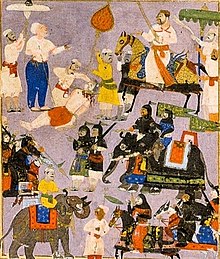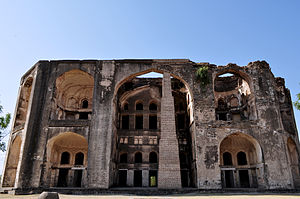Ahmadnagar Sultanate
Sultanate of Ahmednagar | |||||||||
|---|---|---|---|---|---|---|---|---|---|
| 28 May 1490–1636 | |||||||||
|
Flag Ahmad Nizam Shah I (first) | |||||||||
• 1633–1636 | Murtaza Nizam Shah III (last) | ||||||||
| History | |||||||||
• Established | 28 May 1490 | ||||||||
• Disestablished | 1636 | ||||||||
| Currency | Falus[3] | ||||||||
| |||||||||
| Today part of | India | ||||||||
The Sultanate of Ahmednagar or the Nizam Shahi Sultanate was a late medieval Indian Muslim kingdom located in the northwestern
Initially his capital was in the town of
History
Establishment
Reigns of the successors of Malik Ahmad

After the death of Malik Ahmad in 1510, his son


After the death of Hussain in 1565, his minor son
Malik Ambar and the demise of the sultanate

Although, Ahmadnagar city and its adjoining areas were occupied by the Mughals, an extensive part of the kingdom still remained in possession of the influential officials of the Nizam Shahi dynasty.
After the death of Malik Ambar in May 1626, his son Fath Khan surrendered to the Mughals in 1633 and handed over the young Nizam Shahi ruler Hussain Shah, who was sent as a prisoner to the fort of Gwalior. But soon, Shahaji with the assistance of Bijapur, placed an infant scion of the Nizam Shahi dynasty, Murtaza Nizam Shah III on the throne and he became the regent. In 1636 Aurangzeb, then Mughal viceroy of Deccan finally annexed the sultanate to the Mughal empire after defeating Shahaji.
Revenue system of Malik Ambar
The revenue system introduced by Malik Ambar was based on the revenue system introduced in Northern India and some parts of Gujarat and Khandesh
Art
Under the reigns of successive rulers of the dynasty, architecture and art flourished in the kingdom. The earliest extant school of
Architecture
A number of palaces such as the Farah Bakhsh Bagh, Ahmadnagar Fort, Hasht Bihisht Bagh, and Manjarsumbah are in and around Ahmadnagar city. There exist tombs of nobles like Salabat Khan and Changiz Khan, and also of saints like Shah Sharif and Bava Bangali.[24]
Malik Ambar is credited with the construction of the Janjira Fort in the Murud Area of present-day Maharashtra India.[25] After its construction in 1567 AD, the fort was key to the Sidis withstanding various invasion attempts by the Marathas, Mughals, and Portuguese to capture Janjira.[26]

Farah Bagh (also called as Faria Bagh) is situated in Ahmednagar, Maharashtra. It is a palace build by Nizam Shahi rulers in Ahmednagar.[27][28][29] Farah Bagh was the centrepiece of a huge palacial complex completed in 1583. It were the special possessions of the royal household and Murtaza

List of rulers
The following is the list of the Nizam Shahi rulers of Ahmadnagar:[15]
- Ahmad Nizam Shah I(1490–1510)
- Burhan Nizam Shah I(1510–1553)
- Hussain Nizam Shah I (1553–1565)
- Murtaza Nizam Shah I (1565–1588)
- Hussain Nizam Shah II (1588–1589)
- Ismail Nizam Shah (1589–1591)
- Burhan Nizam Shah II (1591–1595)
- Bahadur Nizam Shah (1595–1600; under the regency of his great aunt Chand Bibi)
- Ahmad Nizam Shah II (1596)
- Murtaza Nizam Shah II (1600–1610)
- Burhan Nizam Shah III (1610–1631)
- Hussain Nizam Shah III (1631–1633)
- Murtaza Nizam Shah III (1633–1636)
- Mughal historians and Emperors never referred to them as Nizam Shahs but rather as Nizam-ul-Mulk, since they were not recognised as equals.[citation needed]
Family tree
| Nizam Shahi Dynasty | |||||||||||||||||||||||||||||||||||||||||||||||||||||||||||||||||||||||||||||||||||||||||||||||||||||||||||||||||||||||||||||||||||||||||||||||||||||||||||||||||||||||||||||||||||||||||||||||||||||||||||||||||||||||||||||||||||||||||||||||||||||||||||||||||||||||||||||||||||||||||||||||||||||||||||||||||||||||||||||||||||||||||||||||||||||||||||||||||||||||||||||||||||||||||||||||||||||||||||||||||||||||||||||||||||||||||||||||||||||||||||||||||||||||||||||||||||||||||||||||||||||||||||||||||||||||||||||||||||||||||||||||||||||||||||||||||||||||||||||||||||||||||||||||||||||||||||||||||||||||||||||||||||||||||||
|---|---|---|---|---|---|---|---|---|---|---|---|---|---|---|---|---|---|---|---|---|---|---|---|---|---|---|---|---|---|---|---|---|---|---|---|---|---|---|---|---|---|---|---|---|---|---|---|---|---|---|---|---|---|---|---|---|---|---|---|---|---|---|---|---|---|---|---|---|---|---|---|---|---|---|---|---|---|---|---|---|---|---|---|---|---|---|---|---|---|---|---|---|---|---|---|---|---|---|---|---|---|---|---|---|---|---|---|---|---|---|---|---|---|---|---|---|---|---|---|---|---|---|---|---|---|---|---|---|---|---|---|---|---|---|---|---|---|---|---|---|---|---|---|---|---|---|---|---|---|---|---|---|---|---|---|---|---|---|---|---|---|---|---|---|---|---|---|---|---|---|---|---|---|---|---|---|---|---|---|---|---|---|---|---|---|---|---|---|---|---|---|---|---|---|---|---|---|---|---|---|---|---|---|---|---|---|---|---|---|---|---|---|---|---|---|---|---|---|---|---|---|---|---|---|---|---|---|---|---|---|---|---|---|---|---|---|---|---|---|---|---|---|---|---|---|---|---|---|---|---|---|---|---|---|---|---|---|---|---|---|---|---|---|---|---|---|---|---|---|---|---|---|---|---|---|---|---|---|---|---|---|---|---|---|---|---|---|---|---|---|---|---|---|---|---|---|---|---|---|---|---|---|---|---|---|---|---|---|---|---|---|---|---|---|---|---|---|---|---|---|---|---|---|---|---|---|---|---|---|---|---|---|---|---|---|---|---|---|---|---|---|---|---|---|---|---|---|---|---|---|---|---|---|---|---|---|---|---|---|---|---|---|---|---|---|---|---|---|---|---|---|---|---|---|---|---|---|---|---|---|---|---|---|---|---|---|---|---|---|---|---|---|---|---|---|---|---|---|---|---|---|---|---|---|---|---|---|---|---|---|---|---|---|---|---|---|---|---|---|---|---|---|---|---|---|---|---|---|---|---|---|---|---|---|---|---|---|---|---|---|---|---|---|---|---|---|---|---|---|---|---|---|---|---|---|---|---|---|---|---|---|---|---|---|---|---|---|---|---|---|---|---|---|---|---|---|---|---|---|---|---|---|---|---|---|---|---|---|---|---|---|---|---|---|---|---|---|---|---|---|---|---|---|---|---|---|---|---|---|---|---|---|---|---|---|---|---|---|---|---|---|---|---|---|---|---|---|---|---|---|---|---|---|---|---|---|---|---|---|---|---|---|---|---|---|---|---|---|---|---|---|---|---|---|---|---|---|---|---|---|---|---|---|---|---|---|---|---|---|---|---|---|---|---|---|---|---|---|---|---|---|---|---|---|---|---|---|---|---|---|---|---|---|---|---|---|---|---|---|---|---|---|---|---|---|---|---|---|---|---|---|---|---|---|---|---|---|---|---|
| |||||||||||||||||||||||||||||||||||||||||||||||||||||||||||||||||||||||||||||||||||||||||||||||||||||||||||||||||||||||||||||||||||||||||||||||||||||||||||||||||||||||||||||||||||||||||||||||||||||||||||||||||||||||||||||||||||||||||||||||||||||||||||||||||||||||||||||||||||||||||||||||||||||||||||||||||||||||||||||||||||||||||||||||||||||||||||||||||||||||||||||||||||||||||||||||||||||||||||||||||||||||||||||||||||||||||||||||||||||||||||||||||||||||||||||||||||||||||||||||||||||||||||||||||||||||||||||||||||||||||||||||||||||||||||||||||||||||||||||||||||||||||||||||||||||||||||||||||||||||||||||||||||||||||||
Notes
- ^ The flag of the Nizam Shahi dynasty of the Ahmadnagar Sultanate,the flag had a Quranic verse engraved: He will also give you another favour that you long for: help from Allah and an imminent victory. So give good news O Prophet to the believers.Quran, chapter 61, verse 13, As-Saff
- Chalukyas. Rama Raya sought to control the territory in his bid to gain popular legitimacy by establishing himself as the true heir to Chalukya sovereignty and glory. Other examples included retrofitting of decayed Chalukya complexes and bringing back Chalukya festivals.
References
- ISBN 0226742210.
- ISBN 9004061177.
- ^ Stan Goron and J.P. Goenka, The coins of the Indian sultanates : covering the area of present-day India, Pakistan, and Bangladesh (New Delhi : Munshiram Manoharlal, 2001).
- ^ Journal of the Asiatic Society of Bengal:Volume 44. Bishop's College Press. 1875. p. 38.
- ISBN 9780520042353.
- ISBN 9781784537944.
- ^ ISBN 978-9-38060-734-4.
- ISBN 978-1-317-32127-9.
- ^ Ferishta, Mahomed Kasim (1829). History of the Rise of the Mahometan Power in India, till the year A.D. 1612 Volume III. Translated by Briggs, John. London: Longman, Rees, Orme, Brown and Green. p. 189.
- ^ The Glasgow Herald - Google News Archive Search. 28 January 1857. Retrieved 11 September 2020.
- ISBN 9789004264021.
- S2CID 219697794.
- ISBN 978-0-674-06736-3.
- ^ ISBN 81-7276-407-1, pp.415–45
- ^ ISBN 0-521-56321-6, p.274
- ^ Pushkar Sohoni. "Change and Memory in Farah Bagh, Ahmadnagar" in Journal of Deccan Studies, v. 5 no. 2 (Jul–Dec 2007), pp. 59–77.
- ^ Pushkar Sohoni. "Architecture of the Nizam Shahs" in Helen Philon (ed.), Silent Splendour: Palaces of the Deccan, 14th – 19th centuries (Mumbai: Marg Publications, 2010).
- ISBN 9788184957020.
- ^ Aftabi (1987). Mate, M.S.; Kulkarni, G.T. (eds.). Tarif-i-Husain Shah, Badshah Dakhan. Pune: Bharat Itihas Samshodhan Mandal.
- ^ Gode, P.K. (1944). "Sabaji Prataparaja, a protege of Burhan Nizam Shah of Ahmadnagar, and his works between 1500 and 1560". The Indian Historical Quarterly. 20: 96.
- ISBN 9780814767559.
- ^ Astarabadi (Firishtah), Muḥammad Qāsim Hindū Shāh. Briggs, John (ed.). History of the Rise of the Mahomedan Power in India, vol 3. London: Longman, Rees, Orme, Brown and Green. p. 201.
- ^ Pushkar Sohoni. "Patterns of Faith: Mosque Typologies and Sectarian Affiliation in the Kingdom of Ahmadnagar" in David Roxburgh (ed.), Envisioning Islamic Art and Architecture: Essays in honor of Renata Holod (Leiden: Brill, 2014).
- ISBN 9780755606795.
- ^ Sohoni, Pushkar (2020). The Fort of Janjira. Greensboro, NC; Ahmedabad: University of North Carolina Ethiopian and East African Studies Project; Ahmedabad Sidi Heritage and Educational Center. pp. 167–183.
{{cite book}}:|work=ignored (help) - ^ Kainthla, Anita (August 2011). "The Invincible Fort of Murud Janjira". India Currents. 25 (5): 56–57 – via ProQuest.
- ^ "How 16th-century Ahmednagar palace in Maharashtra stayed cool in summer". Hindustan Times. 26 May 2019. Retrieved 25 October 2019.
- ISBN 0521563216. Retrieved 20 June 2013.
- S2CID 164648431.
- ISBN 9788171569281. Retrieved 17 May 2015.
Further reading
- Shyam, Radhe (2008). Kingdom of Ahmadnagar, Delhi: Motilal Banarsidass, ISBN 81-208-2651-5
- Sohoni, Pushkar (2010). "Local Idioms and Global Designs: Architecture of the Nizam Shahs" Archived 31 October 2013 at the Wayback Machine (Doctoral dissertation, University of Pennsylvania).
- Sohoni, Pushkar(2015), Aurangabad with Daulatabad, Khuldabad and Ahmadnagar, Mumbai : Jaico Publishing House; London : Deccan Heritage Foundation, ISBN 9788184957020
- Chopra, R.M. (2012), The Rise, Growth And Decline in Indo-Persian Literature, Iran Culture House, New Delhi, Chapter on "Persian Literature in Ahmadnagar Sultanate".

